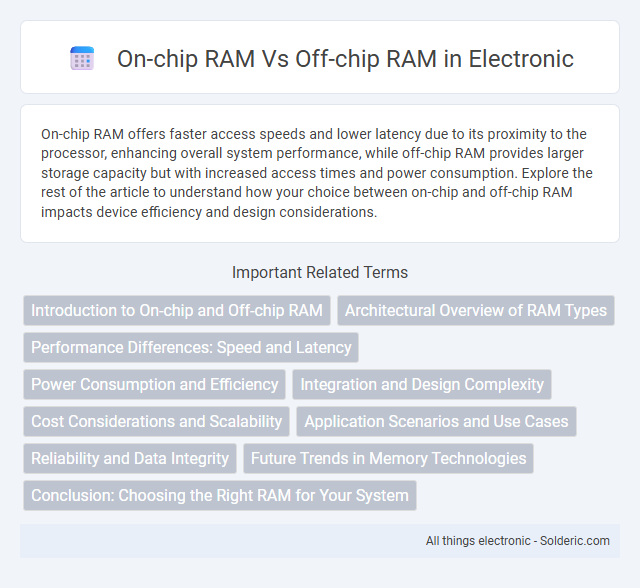On-chip RAM offers faster access speeds and lower latency due to its proximity to the processor, enhancing overall system performance, while off-chip RAM provides larger storage capacity but with increased access times and power consumption. Explore the rest of the article to understand how your choice between on-chip and off-chip RAM impacts device efficiency and design considerations.
Comparison Table
| Feature | On-chip RAM | Off-chip RAM |
|---|---|---|
| Location | Inside the CPU chip | External to the CPU chip |
| Speed | Faster access, low latency | Slower access, higher latency |
| Capacity | Limited, usually KB to low MB | Large, typically several GB |
| Power Consumption | Lower power usage | Higher power usage due to I/O |
| Cost | More expensive per bit | Less expensive per bit |
| Typical Use | Cache, registers, scratchpad | Main memory, DRAM modules |
| Access Method | Direct CPU access | Access via memory controller |
| Bandwidth | Higher bandwidth | Lower bandwidth compared to on-chip |
Introduction to On-chip and Off-chip RAM
On-chip RAM is integrated directly within the processor chip, offering faster access speeds and lower latency due to its proximity to the CPU cores. Off-chip RAM, typically external to the processor, provides larger memory capacity but suffers from higher latency and slower access times caused by the physical distance and bus interface limitations. The choice between on-chip and off-chip RAM impacts system performance, power consumption, and overall design complexity in embedded and computing systems.
Architectural Overview of RAM Types
On-chip RAM is integrated directly within the processor chip, offering faster access speeds and lower latency due to proximity to the CPU cores, which enhances overall performance for critical tasks. Off-chip RAM, typically DRAM modules located outside the CPU die, provides larger storage capacity but incurs higher latency because of the physical distance and interface overhead. Your system architecture benefits from balancing these RAM types to optimize speed and capacity based on workload requirements.
Performance Differences: Speed and Latency
On-chip RAM offers significantly faster access speeds and lower latency compared to off-chip RAM due to its physical proximity to the processor, enabling rapid data retrieval and improved overall system performance. Off-chip RAM, such as DRAM modules, experiences higher latency caused by longer data transmission paths and slower bus interfaces, which can bottleneck processing speed in memory-intensive applications. These performance differences make on-chip RAM ideal for cache memory and real-time processing, while off-chip RAM serves better for large data storage needing less immediate access.
Power Consumption and Efficiency
On-chip RAM offers significantly lower power consumption compared to off-chip RAM due to its close proximity to the processor, reducing signal transmission energy and latency. The integration of on-chip RAM enables higher efficiency in data access and processing speeds, crucial for battery-powered and performance-sensitive applications. Off-chip RAM, while providing larger capacity, demands more power for data transfer across the chip boundary, impacting overall energy efficiency in embedded and portable devices.
Integration and Design Complexity
On-chip RAM is integrated directly within the processor die, reducing latency and enabling faster data access with lower power consumption. Off-chip RAM, positioned outside the CPU, requires complex bus interfaces and additional circuitry, increasing design complexity and potential bottlenecks in data transfer. The integration of on-chip RAM also simplifies PCB design and enhances system reliability compared to the more intricate routing needed for off-chip memory components.
Cost Considerations and Scalability
On-chip RAM offers lower latency and power consumption but comes at a higher cost per bit due to limited silicon area, making it less scalable for large memory requirements. Off-chip RAM provides a cost-effective solution with greater scalability, as it can be expanded by adding external memory modules, though it incurs longer access times and increased power usage. Your choice depends on balancing budget constraints with performance needs and future scalability demands.
Application Scenarios and Use Cases
On-chip RAM provides low latency and high-speed access ideal for real-time processing tasks in embedded systems and microcontrollers, while off-chip RAM offers larger storage capacity suited for data-intensive applications like graphics rendering and large-scale data buffering. You benefit from on-chip RAM in scenarios requiring fast, deterministic memory access, such as signal processing and cache storage, whereas off-chip RAM supports applications needing extensive memory resources, including high-performance computing and multimedia systems. Choosing between on-chip and off-chip RAM depends on balancing speed, capacity, and power consumption aligned with your specific use cases.
Reliability and Data Integrity
On-chip RAM offers higher reliability and better data integrity due to its proximity to the processor, which reduces latency and exposure to external interference. Off-chip RAM, while providing larger capacity, is more susceptible to signal degradation and external noise, potentially affecting data accuracy. Your system's performance and stability benefit significantly from the robust error correction and reduced access times inherent in on-chip memory solutions.
Future Trends in Memory Technologies
Future trends in memory technologies emphasize the integration of on-chip RAM to achieve ultra-low latency and higher bandwidth for advanced AI and edge computing applications. Innovations like embedded MRAM and SRAM on-chip aim to reduce power consumption and enhance processing speed by minimizing data transfer bottlenecks. Your system's performance will benefit from these developments, as on-chip memory solutions become more prevalent, complementing off-chip memory for large capacity storage needs.
Conclusion: Choosing the Right RAM for Your System
On-chip RAM offers faster access speeds and lower latency, making it ideal for performance-critical tasks and real-time processing in embedded systems. Off-chip RAM, while slower, provides greater capacity and flexibility for applications requiring large memory storage or extensive data handling. Your system's requirements for speed, capacity, power consumption, and cost will determine the optimal balance between on-chip and off-chip RAM integration.
On-chip RAM vs Off-chip RAM Infographic

 solderic.com
solderic.com